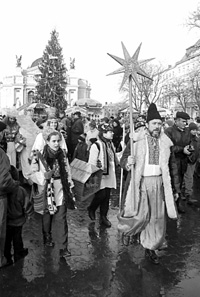Traditions We Lose

“We are Ukrainians. These are our Traditions.” These symbolic lines end a Christmas commercial of one the political ads. It offers an idyllic picture: a traditional log cabin, khata . The master of the house with wife and children, are visited by children singing koliada carols. Everybody is happy and carefree, as befits this major Christian holiday. And the ending words, “These are our traditions.”
A good commercial and good words. No one doubts that we are Ukrainians (we live in Ukraine, don’t we?). As for traditions — well, they are ours, of course, but what makes traditions important is their being observed from year to year, maintained, and handed down. Traditions are the link between the present, past, and future realities. So how do we actually observe our Christmas traditions? Are there many families sitting at a table laid with the prescribed twelve dishes on Christmas Eve? How many have the didukh [sheaf of straw brought into the house on Christmas Eve, symbolizing the souls of the departed ancestors] placed in the pokuttia [a corner in the room which Ukrainians adorn with holy images (icons)]. Do many sing the koliadas? Very few. Of course, one can point out that for decades under the Soviets no one taught us this tradition. This is true. But we have our children, so why not teach them? They are our future and they are the ones to preserve the tradition. Except the problem is who can teach them? Parents? They need being taught themselves. School? The school has become helpless and incompetent. It is common knowledge that folk studies classes are conducted by teachers specializing in different disciplines, because there are no experts. Hence, whoever teaches a class often does not realize the cultural, spiritual importance of the subject. To that teacher, old traditions and festivities are fragments of the past, something that has long become history. Hence the children’s attitude; it is as though they were looking at a museum exhibit in a glass case. They see an object, but they do not see their reflection in it. Given this attitude, such traditions will never become part of their daily life. Instead, surrogate rites are spreading at alarming speed. Hearing children struggling with their koliadas — and I mean ordinary tikes, not performers of folk groups — your hair stands on end.
Two types of carols, koliadkas and shchedrivkas [carols sung on Christmas Eve and Epiphany, respectively), are known to have reached our day from pre-Christian times, as magical eulogizing songs. In them our forefathers placed knowledge acquired over the centuries and required to maintain harmony between man and nature. By singing them, people united with the universe and simultaneously portrayed for the listener the colorful picture of true happiness and well-being, meaning rich harvest, fertile livestock, etc.
So what are today’s Ukrainian carols all about? I was visited once by a group of children who proceeded to recite quickly and not too intelligibly, taking turns:
Koliada, koliad, koliadnytsia
A nice browned loaf with honey,
It doesn’t taste that good without honey.
Hey man, give me five kopiykas.
Well, the coin doesn’t look important.
Better give me a paper ruble.
Actually, just as they entered one of the kids started practically in the doorway:
Koliadka, koliadka,
I am running for my life, it’s so cold!
Better give me a bottle of vodka!
I was speechless. “You really want a drink?” I asked finally The boy blushed, “No, why? It’s just a koliada.” Good heavens! Who taught them this mush? And every koliada/koliadka is supposed to be a gem of folk creativity.
Other trick or treat visitors, older than the first troupe, sang about daddy sending them to get some money and that mother added that they should return with some fatback. And one told me he was “sowing seeds to reap enough to buy myself a car.”
There you are! It is as though our children regarded carols as a means of earning quick money. It is true that in the distant past carol singers were rewarded with doughnuts, candies, and other goodies; they even got money for greeting the master of the house, wishing the family the best of health, luck, peace, and quiet.
Our ancestors were well aware of the magic power of the word, of words spoken with a sincere belief. Thus they chose colorful eulogizing lyrics for the carols, capable, in the words of Ivan Franko, of carrying the listener “into a world near and dear, yet entirely different from the surrounding pitiful and worrisome realities.”
And every detail of the rite was extremely important. For example, the seeds tossed at the host had to be the best, capable of bringing a good harvest of wheat, rye, etc. Now they often throw groats at you, meaning dead grain. Could it be we are thus sowing seeds of discord, disease, and other perils? Experts on folk studies maintain that this is precisely the case.
What a shame, but we have what we have, friends. Before our very eyes age-old traditions are dying out. If this practice continues who can guarantee that in a hundred years from now our descendants will say confidently on Christmas Eve: “We are Ukrainians. These are our traditions dating back millennia”?






